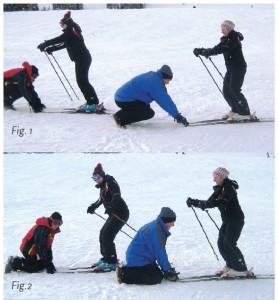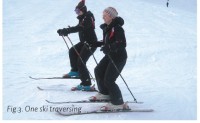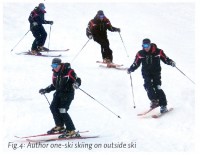A Senior Moment by Ed Kane
Buildi ng on my last article, let’s explore some on snow drills that will enhance balancing skills in senior skiers. These drills are best practiced on easy terrain we typically just schuss across. The goal is to do these drills often enough on gentle terrain so that each time they are practiced the skier is not fearful or encumbered by the terrain. As the skier becomes more comfortable with the drills a “poised” mental and physical state indicates improvement in the balancing movements.
ng on my last article, let’s explore some on snow drills that will enhance balancing skills in senior skiers. These drills are best practiced on easy terrain we typically just schuss across. The goal is to do these drills often enough on gentle terrain so that each time they are practiced the skier is not fearful or encumbered by the terrain. As the skier becomes more comfortable with the drills a “poised” mental and physical state indicates improvement in the balancing movements.
Since age is typically related to stamina, efficient movements will increase the senior skier’s ability to maintain performance levels throughout the day. Recovering from being out of balance consumes large amounts of energy and requires muscle strength to do so. A well balanced skier with an effective stance will experience much less fatigue in the thighs if they maintain balance over the whole foot and apply pressure to the boot tongues, which improves skeletal alignment opposed to leaning against the backs of the boots and using the thigh muscles to remain upright.
 Several exercises (below) can be used to enhance balancing movements and skills at any level of ability, and are especially effective for beginners or for senior skiers who are trying to climb to the next level. These should be introduced on relatively flat, groomed terrain. As the skier begins to master the ability to stay balanced over the whole foot, move to gradually steeper terrain and in more difficult conditions. Awareness of shin and boot cuff contact is paramount. Best learning takes place in conditions that slightly challenge confidence rather than overwhelm.
Several exercises (below) can be used to enhance balancing movements and skills at any level of ability, and are especially effective for beginners or for senior skiers who are trying to climb to the next level. These should be introduced on relatively flat, groomed terrain. As the skier begins to master the ability to stay balanced over the whole foot, move to gradually steeper terrain and in more difficult conditions. Awareness of shin and boot cuff contact is paramount. Best learning takes place in conditions that slightly challenge confidence rather than overwhelm.
- Tip Push/Pull: standing on flat terrain, have a partner slide tips of both skis back and forth a small distance while the skier maintains balance over both feet. Note: the skier (left) does not flex joints together to maintain stance and balance (hips and knee flex/extend more than ankles) whereas the skier (right) maintains stance/balance via functional tension of her muscles to maintain proportional flex of ankles, knees, and hips. (Fig.1 & 2)
- Shuffle: on a gentle slope, alternately shuffle both feet back and forth while gliding down the hill.
- One-ski Glide: glide down a gentle slope alternately lifting one ski and then the other while keeping the lifted ski parallel to the slope. Note: ankle, knee and hips flexion helps maintain balance while gliding forward.
- One-ski Traverse: on downhill ski with uphill ski lifted and parallel to slope. (Fig.3).
- Straight Run, One-ski Hops: hop from ski to ski, while gliding on only one ski between hops – Note: this is a Level I task).
- “J” Turns: from the fall line on one ski, make a single turn in one direction (complete both directions, then try to accomplished the J turn on either the inside or outside edge).
- One-ski Turns: turns on the outside ski with the inside ski lifted and kept parallel to the slope (Fig.4). Then try turns on the inside ski with the outside ski lifted and kept parallel to the slope.
- Slow Turns: linked parallel turns at very slow speeds on flat terrain.
- Uphill Ski Turns: make a series of linked turns on a gentle slope; start by lifting the downhill ski before initiating the turn, then initiate turn from the uphill, weighted ski. HINT: To enhance balance, gently place the uphill edge of the inside ski on the snow prior to lifting the new inside ski and starting the new turn.
 Special thanks to Candice McIvor, Nanci Pererson-Vivian, Justin Peterson and Wayne Bruning for their help in illustrating this article.
Special thanks to Candice McIvor, Nanci Pererson-Vivian, Justin Peterson and Wayne Bruning for their help in illustrating this article.

2 thoughts on “Balance is the Key to Efficient Skiing”
Tip Push/Pull
Has anyone every learned anything from this? It is an interesting demo, but has it improved anyone’s skiing? Learning anything requires many repetitions of correct movements. A brief demo like this may help make a point, but then what?
One-Ski stuff
I feel that raising just the tail of the lightened ski improves the skier’s balance and helps them learn the benefit of being correctly balanced over their foot. Raising the entire ski, even lifted parallel to the slope, puts some people into the backseat and, in any case, does not give them feeling of being strongly planted in the correct balance.
Because learning a movement requires many repetitions of correct movements, I feel it would be more beneficial to a student to practice one or two of the exercises listed, preferably on the “correct” edge, not the “opposite edge” for many repetitions, not to try every exercise a few times.
Good points. The exercises in this ariticle were intended to discuss some tools to add to your teaching tool box and to generate some discussion. I have my favorates and each are used when the sutdent needs are appropriate. However, I find in many cases that for some students the variations that you suggest are more effective. No single approach will click with every student so we need to stay open to trying different approaches that fit the student aptitude and learning styles.
Thanks for the feedback.